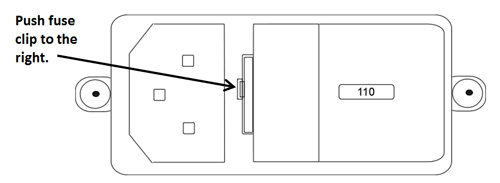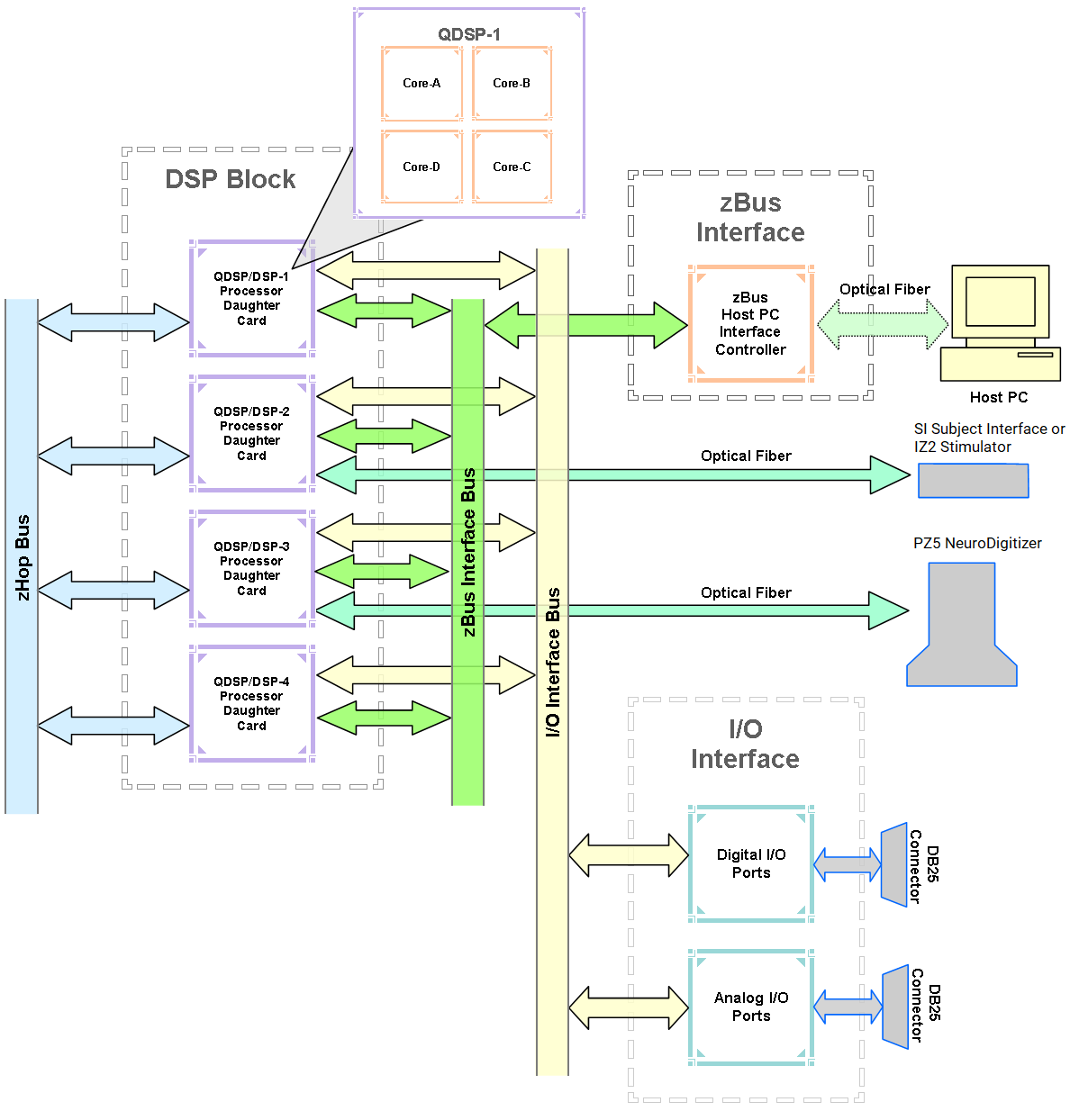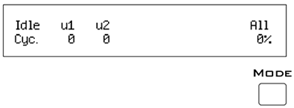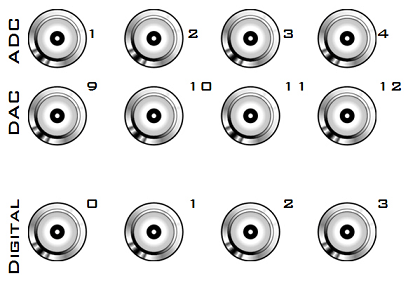RZ5D BioAmp Processor

RZ5D Overview
The RZ5D BioAmp Processor features up to four digital signal processors cards. Any card can be either a single standard processor card (RZDSP) or a quad core processor card (QZDSP). Standard single processor cards use a single Sharc DSP; quad-core processor cards use four Sharc DSPs cores with the potential to more than double the power of the RZ5D. All cards are networked on a multiprocessor architecture that features efficient onboard communication and memory access. The RZ5D is a versatile solution for real-time processing and simultaneous acquisition and stimulation.
The RZ5D acquires and processes up to 32 channels of neurophysiological signals in real-time. Data can be input from a PZ5 amplifier or digital headstage manifold at a sampling rate of up to ~50 kHz. The RZ5D also supports microstimulation applications. The RZ5D can be used with TDT's IZV Subject Interface (SI) for up to 128 channels of stimulation and switching headstages (ZC_SW) to comprise a complete microstimulation system.
Both single and quad-core processors cards may include an optical interface for connection to devices such as the RS4 Data Streamer or a second PZ Amplifier.
The RZ5D also features eight channels of analog I/O, 24 bits of digital I/O and an onboard monitor speaker with volume control.
Power and Communication
The RZ5D's Optibit optical interface connects to a PO5, PO5e, PO5c, or UZ3 computer interface card for fast and reliable data transfer from the RZ2 to the PC. Connectors on the back panel are color coded for correct wiring.
The RZ5D's integrated power supply is shipped from TDT configured for the end user's regional voltage setting (110 V or 220 V). If you need to change the voltage setting:
-
Turn off the RZ5D
-
Use a small flathead screwdriver to gently push the clip along the left side of the fuse plate to the right to remove it.

-
Remove the white AC voltage selector and rotate it until the desired voltage is displayed, then reinsert it and put the fuse plate back on.
The RZ5D is UL compliant, see the RZ5 Operator's Manual for power and safety information.
Software Control
TDT's Synapse software controls the RZ5D and provides users a high level interface for device configuration.
RZ5D Architecture
The RZ5D processor uses a multi-bus architecture and offers three dedicated, data buses for fast, efficient data handling. While the operation of the system architecture is largely transparent to the user, a general understanding is important when designing experiments.
 |
| RZ5D Multi-DSP Architecture Functional Diagram |
As shown in the diagram above, the RZ5D architecture consists of three functional blocks:
Bus Related Delays
A standard two sample delay is associated with the zHop. However, these delays are managed for the user in Synapse software.
RZ5D Features
DSP Status Lights

These LEDs report the status of the multiprocessor's individual DSPs and will be lit solid green when the corresponding DSP is installed and running. The corresponding LED will be lit dim green if the cycle usage on a DSP is 0%. If the demands on a DSP exceed 99% of its capacity on any given cycle, the corresponding LED will flash red (~1 time per second). For QZDSPs, the LED indicates levels for the core with the highest cycle usage.
Front Panel Display Screen

The front panel display screen reports detailed information about the status of the system. The top line reports the system mode, Run!, Idle, or Reset. The second line reports the user's choice of status indicators for each DSP followed by an aggregate value.
The user can cycle through the various status indicators using the Mode button to the bottom right of the display. Push and release the button to change the display or push and hold the button for one second then release to automatically cycle through each of the display options. The display screen may also report system status such as booting status (Reset).
Note
When burning new microcode or if the firmware on the RZ is blank, the display screen will report a cycle usage of 99% and the processor status lights will flash red.
PZ Preamplifier Port
The RZ5D acquires digitized signals from a PZ5 preamplifier via a fiber optic cable through the port labeled 'PZ' on the front panel. This port can input up to 32 channels at a maximum sampling rate of ~50 kHz. The PZ port can be used with any of the PZ preamplifier and is configured in Synapse software.
SI Subject Interface Port
The output port labeled SI can be used with a Subject Interface, PZ5 amplifier, or iCon Behavioral Controller for up to 128 channels of electrical stimulation, neurophysiological recording, or behavior control.
Note
RZ5D with serial number <1215 had an IZ port for IZ2 Stimulator support.
Onboard Analog I/O
The RZ5D is equipped with four channels of 16-bit PCM D/A and four channels of 16-bit PCM A/D. All 8 channels can be accessed via front panel BNCs marked ADC and DAC or via a 25-pin analog I/O connector. See RZ5D Technical Specifications for the DB25 pinout.
The following table provides a quick overview of the analog I/O features and how they must be accessed during experiment design.
Monitor Speaker
The RZ5D is equipped with an onboard speaker. To use the speaker, feed the desired signal to the first DAC output channel. The speaker is provided primarily for audio monitoring of a single channel of electrophysiological potentials during recording.
Digital I/O
The digital I/O ports include 24 bits of programmable I/O. The digital I/O is divided into three bytes (A, B, and C) as described in the chart below. All digital I/O lines are accessed via the 25-pin connector on the front of the RZ5D and bits 0 - 3 of byte C are available through BNC connectors on the front panel labeled Digital. See RZ5D Technical Specifications for the DB25 pinout.
The digital I/O is configured in the Synapse RZn Hal.
*Note: Byte C Bits 0 - 3 are available via front panel BNCs
The data direction for the Digital I/O is also configured in the Synapse RZn Hal.
The RZ digital I/O ports have different voltage outputs and logic thresholds depending on the type. Below is a table listing the different voltage outputs and thresholds for both types.
LED Indicators
The RZ5D has 16 LED indicators for the analog and digital I/O located directly below the display screen and DSP status LEDs.
Digital I/O
These LEDs indicate the state of the 8 bit-addressable I/O of byte C.
Analog I/O
These LEDs indicate the state of the four ADC and four DAC channels.
UDP Ethernet Interface
The RZ UDP Ethernet interface can transfer low bandwidth data directly to or from a PC. RZ devices equipped with a UDP interface have an additional Ethernet port and RS232 serial port located on the back panel. See RZ-UDP Communications Interface for more information.
Specialized DSP/Optical Interface Boards
The RZ standard DSP boards can be replaced with specialized DSP boards which include an optical interface for communication and control of RZ compatible devices, such as the Subject Interface and RS4 Data Streamer. RZ devices equipped with one or more specialized DSP boards include an optical port for each card. The ports are located on the front panel and labeled for easy identification.
RZ5D Technical Specifications
Note
Specifications for amplifier A/D converters are found under the preamplifier's technical specifications.
Note
Technical specifications for preamplifier A/D converters and stimulator outputs are found in the specific preamplifier / stimulator document.
BNC Channel Mapping
Please note channel numbering begins at the top left block of BNCs for both analog and digital I/O and is printed on the face of the device to minimize miswiring.

DB25 Analog I/O Pinout

DB25 Digital I/O Pinout

If using a PP24 Patch Panel, see PP24 to RZ5D Digital I/O.